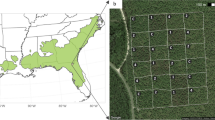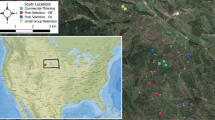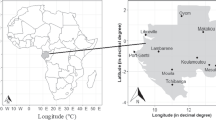Abstract
The aim of the study is to compare selected theoretical distributions (normal, lognormal, Weibull, gamma, logistic, and exponential) in describing the tree diameter (DBH) distributions of mixed near-natural forests consisting of fir Abies alba Mill. and beech Fagus sylvatica L. growing in various vertical structures. Tree DBH data were collected between 1997 and 2008 from 51 sample plots established in the Świętokrzyski National Park in Poland. The empirical data represent differentiated DBH distributions, ranging from almost symmetric to extremely asymmetric ones. The chi-square test and the modified Kolmogorov–Smirnov test were chosen for the goodness-of-fit testing. In addition to the test statistics, the bias (B), the root mean square error (RMSE) and the graphical method (quantile–quantile plots) were used. In one-storied stands, the most suitable distributions were the normal and logistic distributions; in two-storied and multilayered stands, the Weibull and gamma distribution were the most suitable; and in selection stands, the exponential distribution was the most appropriate to describe the DBH distribution. The order of precision of the tested distributions (from the highest to the lowest) was Weibull, gamma, logistic, normal, exponential, and lognormal. The normal and exponential distribution should be applied only to one-storied and selection forests, respectively. The least suitable distribution for DBH distribution modelling was the lognormal one.






Similar content being viewed by others
References
Ammon W (1995) Das Plenterprinzip in der Waldwirtschaft. P Haupt, Bern
Assmann E (1970) The principles of forest yield study. Pergamon Press, Oxford
Bernadzki E, Żybura H (1989) Tempo wzrostu wysokości buka w dolnym piętrze drzewostanów sosnowych. Sylwan 133(5):33–40
Borders BE, Patterson WD (1990) Projecting stand tables: a comparison of the Weibull diameter distribution method, a percentile-based projection method and a basal area growth projection method. For Sci 36:413–424
Borders BE, Souter RA, Bailey RL, Ware KD (1987) Percentilebased distributions characterize forest stand tables. For Sci 33:570–576
D’Agostino RB, Stephens MA (1986) Goodness-of-fit techniques. Marcel Dekker, New York
de Liocourt F (1898) De l’aménagement des sapinères. Bull Soc Forest Franche-Comté et Belfort 4:396–409
Dittmar O (1990) Untersuchungen im Buchen-Plenterwald Keula. Forst und Holz 45:419–423
Dittmar O (1992) Vorteile und Nachteile der langfristigen einzelstammweisen Nutzung in den Buchenwäldern Nordwest-Thüringens. Schweiz Z Forstwes 143:431–441
FAO ISRIC ISSS (1998) World reference base for soil resources. 84 World Soil Resources Reports. FAO, Rome
Gerold D, Biehl R (1992) Vergleich zwischen Buchenplenterwald und Buchenbetriebsklasse. Allg Forstzeitschr 47:91–94
Goelz JCG, Leduc DJ (2002) A Model describing growth and development of longleaf pine plantations: consequences of observed stand structures of structure of the model. Gen Tech Rep SRS-48. U.S. Department of Agriculture, Forest Service, Southern Research Station, Asheville, pp 438–442
Jaworski A (1997) Karpackie lasy o charakterze pierwotnym i ich znaczenie w kształtowaniu proekologicznego modelu gospodarki leśnej w górach. Sylwan 141(4):33–49
Jaworski A, Podlaski R, Waga T (1999) Budowa i struktura drzewostanów o charakterze pierwotnym w rezerwacie Święty Krzyż (Świętokrzyski Park Narodowy). Acta Agr Silv Ser Silv 37:27–51
Jaworski A, Kołodziej Z, Opyd Z (2000) Bukowe lasy o charakterze pierwotnym jako model lasów przerębowych. Acta Agr Silv Ser Silv 38:3–31
Karczmarski J (2005) Struktura rozkładów pierśnic w naturalnych górnoreglowych borach świerkowych Tatr i Beskidów Zachodnich w zależności od stadiów i faz rozwojowych lasu o charakterze pierwotnym. Sylwan 149(3):12–23
Korpel’ Š (1995) Die Urwälder der Westkarpaten. G Fischer-Verlag, Stuttgart
Köstler JN (1956) Allgäuer Plenterwaldtypen. Forstwiss Centralbl 75:422–458
Kowalkowski A (2000) Gleby. In: Cieśliński S, Kowalkowski A (eds) Świętokrzyski Park Narodowy. Przyroda, gospodarka, kultura. Świętokrzyski Park Narodowy, Bodzentyn, Kraków, pp 169–196
Law AM, Kelton WD (1999) Simulation modeling and analysis. McGraw-Hill, New York
Leibundgut H (1945) Waldbauliche Untersuchungen über den Aufbau von Plenbterwäldern. Mitt Schweiz Anst Forstl Versuchsw 24:219–296
Liu C, Zhang L, Davis CJ, Solomon DS, Gove JH (2002) A finite mixture model for characterizing the diameter distribution of mixed-species forest stands. For Sci 48:653–661
Maltamo M (1997) Comparing basal area diameter distributions estimated by tree species and for the entire growing stock in a mixed stand. Silva Fenn 31:53–65
Maltamo M, Kangas A (1998) Methods based on k-nearest neighbor regression in estimation of basal area diameter distribution. Can J For Res 28:1107–1115
Maltamo M, Puumalainen J, Päivinen R (1995) Comparison of beta and Weibull functions for modeling basal area diameter distribution in stands of Pinus sylvestris and Picea abies. Scand J For Res 10:284–295
MANUGISTICS (2001) Statgraphics Plus ver. 5.1. STSC. Rockville, Maryland
Matuszkiewicz JM (2002) Zespoły leśne Polski. PWN, Warszawa
Merganič J, Sterba H (2006) Characterisation of diameter distribution using the Weibull function: method of moments. Eur J For Res 125:427–439
NIST/SEMATECH (2008) Quantile–quantile plot. e-Handbook of statistical methods. www.itl.nist.gov/div898/handbook/eda/section3/qqplot.htm
Palahí M, Pukkala T, Blasco E, Trasobares A (2007) Comparison of beta, Johnson’s SB, Weibull and truncated Weibull functions for modeling the diameter distribution of forest stands in Catalonia (north-east of Spain). Eur J For Res 126:563–571
Podlaski R (2003) A statistical small-area method of estimation of spatial distribution of the tree damage degree. J For Sci 49:384–392
Podlaski R (2006) Suitability of the selected statistical distributions for fitting diameter data in distinguished development stages and phases of near-natural mixed forests in the Świętokrzyski National Park (Poland). For Ecol Manage 236:393–402
Poznański R (1997) Typy rozkładu pierśnic a stadia rozwojowe lasów o zróżnicowanej strukturze. Sylwan 141(3):37–44
Pretzsch H (1995) Perspektiven einer modellorientierten Waldwachstumforschung. Forstwiss Centralbl 114:188–209
Pretzsch H (1997) Analysis and modelling of spatial stand structures. Methodological considerations based on mixed beech-larch stands in Lower Saxony. For Ecol Manage 97:237–253
Pretzsch H (1998) Structural diversity as a result of silvicultural operations. Lesnictvi-Forestry 44:429–439
Pretzsch H (2001) Models for pure and mixed forests. In: Evans J (ed) The forests handbook. Blackwell Science, London, pp 210–228
Reynolds MR, Burk T, Huang W-H (1988) Goodness-of-fit tests and model selection procedures for diameter distribution models. For Sci 34:373–399
Rymer-Dudzińska T, Dudzińska M (1999) Analiza rozkładu pierśnic w drzewostanach bukowych. Sylwan 143(8):5–24
Rymer-Dudzińska T, Dudzińska M (2001) Rozkład pierśnic drzew w nizinnych drzewostanach bukowych. Sylwan 145(8):13–22
Schütz JP (1981) Que peut apporter le jardinage à notre sylviculture? Schweiz Z Forstwes 132:219–242
Siekierski K (1991) Three methods of estimation of parameters in the double normal distribution and their applicability to modeling tree diameter distributions. Ann Warsaw Agric Univ SGGW For Wood Technol 42:13–17
Siipilehto J (1999) Improving the accuracy of predicted basal: area diameter distribution in advanced stands by determining stem number. Silva Fenn 33:281–301
Trepp W (1974) Der Plenterwald. HESPA-Mitt 66:1–65
Wolfram S (2003) The mathematica book, 5th edn. Wolfram Media/Cambridge University Press, Cambridge
Zarnoch SJ, Dell TR (1985) An evaluation of percentile and maximum likelihood estimators of Weibull parameters. For Sci 31:260–268
Zasada M (1995) Ocena zgodności rozkładów pierśnic w drzewostanach jodłowych z niektórymi rozkładami teoretycznymi. Sylwan 139(12):61–69
Zasada M (2000) Ocena zgodności rozkładów pierśnic drzew drzewostanów brzozowych z niektórymi rozkładami teoretycznymi. Sylwan 144(5):43–48
Zasada M, Cieszewski CJ (2005) A finite mixture distribution approach for characterizing tree diameter distributions by natural social class in pure even-aged Scots pine stands in Poland. For Ecol Manage 204:145–158
Zhang LJ, Liu C (2006) Fitting irregular diameter distributions of forest stands by Weibull, modified Weibull, and mixture Weibull models. J For Res 11:369–372
Zhang LJ, Gove JH, Liu C, Leak WB (2001) A finite mixture of two Weibull distributions for modeling the diameter distributions of rotated-sigmoid, uneven-aged stands. Can J For Res 31:1654–1659
Zhang LJ, Packard KC, Liu C (2003) A comparison of estimation methods for fitting Weibull and Johnson’s SB distributions to mixed spruce–fir stands in northeastern North America. Can J For Res 33:1340–1347
Zucchini W, Schmidt M, von Gadow K (2001) A model for the diameter–height distribution in an uneven-aged beech forest and a method to assess the fit of such models. Silva Fenn 35:169–183
Acknowledgments
The corrections and suggestions of the editor and anonymous reviewers greatly improved the quality of the paper.
Author information
Authors and Affiliations
Corresponding author
Additional information
Communicated by H. Pretzsch.
Rights and permissions
About this article
Cite this article
Podlaski, R., Zasada, M. Comparison of selected statistical distributions for modelling the diameter distributions in near-natural Abies–Fagus forests in the Świętokrzyski National Park (Poland). Eur J Forest Res 127, 455–463 (2008). https://doi.org/10.1007/s10342-008-0229-3
Received:
Revised:
Accepted:
Published:
Issue Date:
DOI: https://doi.org/10.1007/s10342-008-0229-3




